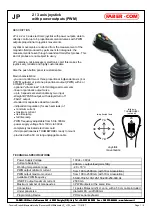
Type S402Y
4
applicable codes) to prevent service
conditions from exceeding those limits.
additionally, physical damage to the
regulator could result in personal
injury or property damage due to
escaping gas.
To avoid such injury and damage, install
the regulator in a safe location.
1.
Only personnel qualified through training and
experience should install, operate, and maintain a
regulator. Before installing a Type S402Y
regulator, check for damage which have might
ocurred in shipment. Also check for dirt or foreign
materials which may have accumulated in the
regulator body or in the pipeline.
2. The Type S402Y may be installed in any position
(vertical or horizontal). Apply a good grade of
pipe compound to the male threads (being
sure not to apply pipe compound to flow path
of the pipe) of the pipe and install the regulator
so the flows is in the direction of the arrow cast
on the body. Use approved piping procedures
when installing the regulator. The spring case can
be rotated to any position relative to the body.
!
WaRning
a regulator may vent some gas to
the atmosphere. in hazardous or
flammable gas service, vented gas
may accumulate, and cause personal
injury, death, or property damage due
to fire or explosion. Vent a regulator
in hazardous gas service to a remote,
safe location away from air intakes or
any hazardous location. The vent line
or stack opening must be protected
against condensation or clogging.
under enclosed conditions or indoors,
escaping gas may accumulate and be
an explosion hazard. in these cases,
the Type S402Y vent should be piped
away from the regulator to a safe
location outdoors.
3. On outdoors installations, regulators installed with
vents in positions other than vertically down
require additional vent protection from the
elements. Such protection may be with separate
hood, shields, or the Fisher
®
Y602 Series vents.
4. Regulator operation within the ratings does not
preclude the possibility of damage from the debris
in the lines or from external sources. A regulator
should be inspected for damage periodically and
after any overpressure condition.
5. With proper installation completed, slowly open
the upstream and downstream shutoff valves.
Check all connections for leaks. Check the
downstream equipment for proper operation.
6. If outlet pressure adjustment is necessary, monitor
downstream pressure with a gauge during the
adjustment procedure. To increase the outlet
pressure, the adjusting screw (key 12, Figure 1)
must be turned clockwise. This requires removal of
the closing cap (key 11, Figure 1). To reduce the
outlet pressure setting, turn the adjusting screw
counter-clockwise. Do not adjust the spring to
procedure an outlet pressure setting above the limit
stamped on the regulator.
Overpressure Protection
The wide-open C
g
for relief sizing along with the
capacity information should be used in choosing
appropriate overpressure protection devices to
ensure that none of the limits in the Specifications
section, Table 1, or Table 2 are exceeded.
Overpressuring any portion of a regulator or
associated equipment may cause leakage,
parts damage, or personal injury due to bursting
of pressure-containing parts or explosion of
accumulated gas. Regulator operation within ratings
does not prevent the possibility of damage from
external sources or from debris in the pipeline. A
regulator should be inspected for damage after any
overpressure condition.
Startup
!
WaRning
in order to avoid an overpressure
condition and possible equipment
damage, pressure gauges should
always be used to monitor pressures
during startup.


























